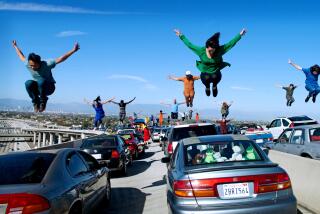When the Franciscan fathers who founded the...
- Share via
When the Franciscan fathers who founded the San Gabriel Mission enlisted the help of the local Native Americans--subsequently dubbed Gabrielenos--they also had them build a series of escape tunnels in case the Indians wearied of their association and rose against them.
Buried in those tunnels, legend has it, is $2,000 worth of gold coins, given to one of the Spanish priests (before he took his vows) by a lady friend in case he needed money in the New World.
Since that time, 225 years ago, San Gabriel--”The City With a Mission”--the first European settlement in the Los Angeles area, has been home to such diverse enterprises as Wham-O Toys, where such icons of American leisure as the Hula Hoop and Frisbee were produced.
Surrounding the mission was a community of Indians whose labor would make San Gabriel the most prosperous of the California missions and help it become the foundation of the city’s early economy. By 1818, the community was producing olive oil, tallow, soap, hides, shoes, clothing and 400 to 600 barrels of wine. Supplies at the mission, including its liquid spirits, helped sustain other fledgling settlements, including the Pueblo of Our Lady Queen of the Angeles, later known simply as Los Angeles.
That same year, the first Yankee to see Los Angeles, a former Boston ship maker named Joseph Champman, settled nearby, where the Santa Anita racetrack stands today. With his carpentry skills, Chapman built the city’s first ship for the Padres’ sea otter hunting expeditions and named it Guadalupe after his wife. With the help of the Indians, Chapman moved the ship by sections to San Pedro, where it was assembled and launched.
After California passed into American hands, Washington granted the mission a small portion of its original acreage in 1853. By then, however, the mission was no longer prosperous, and by the late 1880s the mission was in ruins.
Later, reconstruction financed by public donations began. Although San Gabriel was not officially incorporated until 1913, the community’s dream of establishing their town with a population of 1,500--anchored by the mission--was virtually assured with the railroad already slicing through it, a tiny airport with a hangar and one runway, and vast orange groves north of Las Tunas Boulevard.
Soon after World War II ended and the town began to grow, two USC grads began a mail-order business called Wham-O, by making 75-cent slingshots, then moved on to ship toys around the world--Silly String, Slip ‘N Slides and Frisbees. They also invented the Hula Hoop, shipping 100 million in the first 16 months and employing more than 1,000 people. In 1994, Mattel bought Wham-O and closed its original 171,000-square-foot warehouse, which has been rezoned and is part of a redevelopment plan for the area.
The city with two missions recently gave the mission district a $1.8-million face-lift, which includes sidewalk tiles designed by 600 fourth-graders, along a historic walking tour. The beautification efforts helped the city earn the National League of Cities 1994 award for urban enrichment.
(BEGIN TEXT OF INFOBOX / INFOGRAPHIC)
By the Numbers
CITY BUSINESS
Incorporated: April 24, 1913
Square miles: 4
Number of city parks: 4
City employees: 172 fulltime, 40 part time
1996-97 operating budget: 14 million (capital & restricted funds excluded)
ETHNIC MAKEUP
Latino: 36%
White: 30%
Asian: 32%
Black / Other: .1%
PEOPLE
Population: 37,120
Households: 12,238
Average household size: 3
Median age: 33
MONEY AND WORK
Median household income: $32,559
Median household income/LA County: $34,965
Median home value: $248,000
Employed (16 and older): 18,415
Percentage of women employed: 54%
Percentage of men employed: 74%
Self-employed: 1,405
Car-poolers: 2,53061,301
FAMILIES
Married couple families with children: 24%
Married couple families with no children: 24%
Other types of families: 15%
Nonfamily households: 38%
RETAIL STORES
Number of stores: 259
Number of employees: 1,352
Annual sales: $164 million
Source: Claritas Inc. retail figures are for 1995. All other figures are for 1990. Percentages have been rounded to the nearest whole number.
More to Read
Sign up for Essential California
The most important California stories and recommendations in your inbox every morning.
You may occasionally receive promotional content from the Los Angeles Times.










